Don't wanna be here? Send us removal request.
Text
Mars Study Final Submission
Dear Readers,
This is the final article on Mars Crater Study. This week I have studied the graphical representation of the selected variables to find the answer to my initial research questions. All the visualizations and findings are mentioned in this article.
I have selected following variables to plot:
For univariate graph :
- Crater diameter
- Crater depth to diameter ratio
- Crater latitude
For bivariate graph :
- Crater depth vs Crater diameter
- Crater depth vs Latitude
- Crater depth to diameter ratio vs latitude
- Number of layers vs Crater depth
I also decided to get a simple statistical description for the following variables:
- Crater diameter
- Crater depth-to-diameter ratio
Here is my code [in Python] :
#importing the required library
import pandas
import numpy
import seaborn
import matplotlib.pyplot as plt
#Set PANDAS to show all columns in DataFrame
pandas.set_option('display.max_columns', None)
#Set PANDAS to show all rows in DataFrame
pandas.set_option('display.max_rows', None)
#reading the mars dataset
data=pandas.read_csv('marscrater_pds.csv', low_memory=False)
print('number of observations(row)')
print(len(data))
print('number of observations(column)')
print(len(data.columns))
print('displaying the top 5 rows of the dataset')
print(data.head())
#dropping the unused columns from the dataset
data = data.drop('CRATER_ID',1)
data = data.drop('CRATER_NAME',1)
data = data.drop('MORPHOLOGY_EJECTA_1',1)
data = data.drop('MORPHOLOGY_EJECTA_2',1)
data = data.drop('MORPHOLOGY_EJECTA_3',1)
print('Selected rows with diameter greater than 3km')
data1=data[(data['DIAM_CIRCLE_IMAGE']>3)]
print(data1.head())
# Frequency distributions
# Crater diameter
print('Count for crater diameters (for diameter greater than 3km)')
c1=data1['DIAM_CIRCLE_IMAGE'].value_counts(sort=True)
print(c1)
p1=data1['DIAM_CIRCLE_IMAGE'].value_counts(sort=True, normalize=True)*100
print(p1)
# Crater depth
print('Count for crater depth')
c2=data1['DEPTH_RIMFLOOR_TOPOG'].value_counts(sort=True)
print(c2)
p2=data1['DEPTH_RIMFLOOR_TOPOG'].value_counts(sort=True, normalize=True)*100
print(p2)
#Number of layers
print('Count for number of layers')
c3=data1['NUMBER_LAYERS'].value_counts(sort=True)
print(c3)
p3=data1['NUMBER_LAYERS'].value_counts(sort=True, normalize=True)*100
print(p3)
#creating the copy of the subset data
data2=data1.copy()
#computing the depth to diameter ratio as a percentage and saving it in a new variable d2d_ratio
data2['d2d_ratio']=(data2['DEPTH_RIMFLOOR_TOPOG']/data2['DIAM_CIRCLE_IMAGE'])*100
data2['d2d_ratio']=data2['d2d_ratio'].replace(0, numpy.nan)
# Split crater diameters into 7 groups to simplify frequency distribution
# 3-5km, 5-10km, 10-20km, 20-50km, 50-100km, 100-200km and 200-500km
data2['D_range']=pandas.cut(data2.DIAM_CIRCLE_IMAGE,[3,5,10,20,50,100,200,500])
#frequency distribution for D_range
c4=data2['D_range'].value_counts(sort=True)
print('Count for crater diameter (per ranges)')
print (c4)
p4=data2['D_range'].value_counts(sort=True, normalize=True)*100
print('Percentage for crater diameter (per ranges)')
print (p4)
# Split crater depth-to-diameter ratios into 5 groups to simplify frequency distribution
# 0-5%, 5-10%, 10-15%, 15-20% and 20-25%
data2['d2d_range']=pandas.cut(data2.d2d_ratio,[0,5,10,15,20,25])
#frequency distribution for d2d_range
c5=data2['d2d_range'].value_counts(sort=True)
print('count for crater depth to diameter ratio')
print(c5)
p5=data2['d2d_range'].value_counts(sort=True,normalize=True)*100
print('percentage for crater depth to diameter ratio')
print(p5)
# Making a copy of the subset data created previously (data2)
data3=data2.copy()
# Ploting crater diameter as a bar graph
seaborn.distplot(data3['DIAM_CIRCLE_IMAGE'].dropna(), kde=False, hist_kws={'log':True});
plt.xlabel('Crater diameter (km)')
plt.ylabel('Occurrences')
plt.title('Crater diameter distribution')
# Ploting crater depth-to-diameter ratio as a bar graph
seaborn.distplot(data3['d2d_ratio'].dropna(), kde=False);
plt.xlabel('Depth-to-diameter ratio in percent')
plt.ylabel('Occurrences')
plt.title('Depth-to-diameter ratio distribution')
# Ploting crater latitude as a bar graph
seaborn.distplot(data3['LATITUDE_CIRCLE_IMAGE'].dropna(), kde=False);
plt.xlabel('Latitude (degrees)')
plt.ylabel('Occurrences')
plt.title('Crater latitude distribution')
#Statistical description
print('Describe crater diameter')
desc1 = data3['DIAM_CIRCLE_IMAGE'].describe()
print(desc1)
print('Describe depth-to-diameter ratio')
desc2 = data3['d2d_ratio'].describe()
print(desc2)
# basic scatterplot: crater depth vs crater diameter
scat1 = seaborn.lmplot(x='DIAM_CIRCLE_IMAGE', y='DEPTH_RIMFLOOR_TOPOG', data=data3)
scat1.set(xlim=(0,500))
scat1.set(ylim=(0,5))
plt.xlabel('Crater Diameter (km)')
plt.ylabel('Crater Depth (km)')
plt.title('Correlation between depth and diameter')
# basic scatterplot: Crater diameter vs latitude
scat2 = seaborn.lmplot(x='LATITUDE_CIRCLE_IMAGE', y='DIAM_CIRCLE_IMAGE', data=data3)
scat2.set(xlim=(-100,100))
scat2.set(ylim=(0,300))
plt.xlabel('Latitude (degrees)')
plt.ylabel('Diameter (km)')
plt.title('Relationship between crater diameter and latitude')
# basic scatterplot: d2d_ratio vs latitude
scat3 = seaborn.lmplot(x='LATITUDE_CIRCLE_IMAGE', y='d2d_ratio', data=data3)
scat3.set(xlim=(-100,100))
scat3.set(ylim=(0,30))
plt.xlabel('Latitude (degrees)')
plt.ylabel('Depth-to-diameter ratio (%)')
plt.title('Relation between depth-to-diameter ratio and latitude')
#Bivariate bar graph: Number of layers vs Crater Depth
seaborn.catplot(x='NUMBER_LAYERS', y='DEPTH_RIMFLOOR_TOPOG', data=data3, kind='bar', ci=None)
plt.xlabel('Number of Layers')
plt.ylabel('Depth of the crater')
plt.title('Relationship between the Number of Layers and the craters Depth')
The output for the code :
number of observations(row) 384343 number of observations(column) 10 displaying the top 5 rows of the dataset CRATER_ID CRATER_NAME ... MORPHOLOGY_EJECTA_3 NUMBER_LAYERS 0 01-000000 ... 0 1 01-000001 Korolev ... 3 2 01-000002 ... 0 3 01-000003 ... 0 4 01-000004 ... 0
[5 rows x 10 columns] Selected rows with diameter greater than 3km LATITUDE_CIRCLE_IMAGE ... NUMBER_LAYERS 0 84.367 ... 0 1 72.760 ... 3 2 69.244 ... 0 3 70.107 ... 0 4 77.996 ... 0
[5 rows x 5 columns] Count for crater diameters (for diameter greater than 3km) 3.02 317 3.03 309 3.06 308 3.05 305 3.01 305
60.07 1 69.95 1 100.78 1 118.24 1 67.50 1 Name: DIAM_CIRCLE_IMAGE, Length: 6039, dtype: int64 3.02 0.398356 3.03 0.388303 3.06 0.387047 3.05 0.383277 3.01 0.383277
60.07 0.001257 69.95 0.001257 100.78 0.001257 118.24 0.001257 67.50 0.001257 Name: DIAM_CIRCLE_IMAGE, Length: 6039, dtype: float64 Count for crater depth 0.00 12821 0.07 1564 0.08 1534 0.10 1475 0.11 1448
3.80 1 2.82 1 2.95 1 2.94 1 3.03 1 Name: DEPTH_RIMFLOOR_TOPOG, Length: 296, dtype: int64 0.00 16.111439 0.07 1.965392 0.08 1.927693 0.10 1.853551 0.11 1.819621
3.80 0.001257 2.82 0.001257 2.95 0.001257 2.94 0.001257 3.03 0.001257 Name: DEPTH_RIMFLOOR_TOPOG, Length: 296, dtype: float64 Count for number of layers 0 60806 1 14633 2 3309 3 739 4 85 5 5 Name: NUMBER_LAYERS, dtype: int64 0 76.411526 1 18.388479 2 4.158237 3 0.928660 4 0.106815 5 0.006283 Name: NUMBER_LAYERS, dtype: float64 Count for crater diameter (per ranges) (3, 5] 32084 (5, 10] 23135 (10, 20] 13470 (20, 50] 8818 (50, 100] 1766 (100, 200] 255 (200, 500] 45 Name: D_range, dtype: int64 Percentage for crater diameter (per ranges) (3, 5] 40.320209 (5, 10] 29.073932 (10, 20] 16.927852 (20, 50] 11.081648 (50, 100] 2.219346 (100, 200] 0.320460 (200, 500] 0.056552 Name: D_range, dtype: float64 count for crater depth to diameter ratio (0, 5] 41025 (5, 10] 15957 (10, 15] 8973 (15, 20] 773 (20, 25] 18 Name: d2d_range, dtype: int64 percentage for crater depth to diameter ratio (0, 5] 61.464357 (5, 10] 23.907051 (10, 15] 13.443502 (15, 20] 1.158122 (20, 25] 0.026968 Name: d2d_range, dtype: float64 Describe crater diameter count 79577.000000 mean 11.366228 std 16.695375 min 3.010000 25% 3.940000 50% 6.060000 75% 12.150000 max 1164.220000 Name: DIAM_CIRCLE_IMAGE, dtype: float64 Describe depth-to-diameter ratio count 79577.000000 mean 4.120458 std 4.076532 min -1.639984 25% 0.915192 50% 2.636440 75% 6.709265 max 23.076923 Name: d2d_ratio, dtype: float64
From the above results it is clear that the distribution of craters diameter is very scattered : the mean is around 11km, but the standard deviation is nearly 17km, indicating a high variability of the crater diameter, as expected.
On the other hand, the depth-to-diameter ratio seems to be much less scattered, the mean value is around 4%, with a standard deviation around 4%, indicating that this ratio is less “volatile” than the diameter itself.
The Univariate Graphs are shown below :

This graph is displayed with a logarithmic y-scale in order to make it more readable. As expected, it shows that the majority of the craters have smaller diameters, while the larger craters are less frequent.
Up to about 400km, this variable (diameter) shows a consistent negative slope, which confirms the relationship mentioned earlier in the project : the larger the craters, the less frequently they occur. Above 400km size, the number of craters are too small and it makes no sense to try to derive any statistics from those.
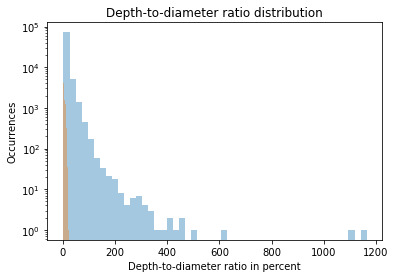
This graph shows Skewed Right distribution. We can see more number of craters for smaller value of the ratio. Which means smaller craters have a smaller depth-to-diameter ratio, while the bigger craters seem to have a bigger depth-to-diameter ratio as well.
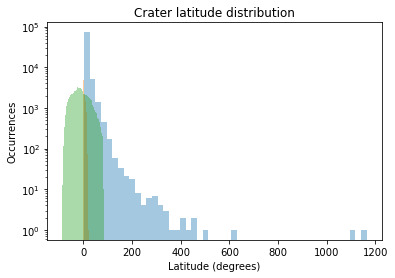
The crater latitude graph also shows the Skewed Right Distribution. We can conclude from the graph that the maximum numbers of craters are located near the Equator.
The Bivariate Graphs are shown below :
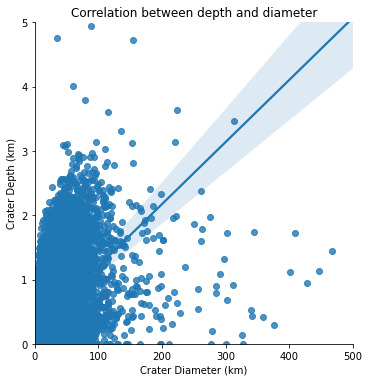
From the graph it is obvious that there is a relationship between these two variables : the greater the diameter, the greater the depth. But the relationship between depth and diameter is somehow weak, as there is a high variability of the scattered plot around the best-fit linear regression.
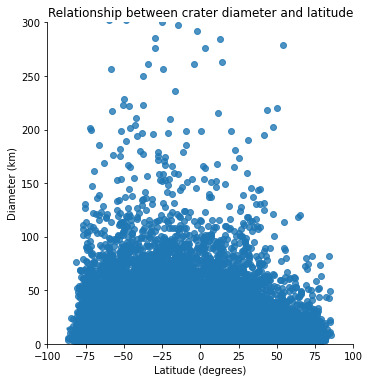
When we plot diameter vs latitude, we see that there is no relationship between these two variables : the location of the impact has apparently no influence on its amplitude.
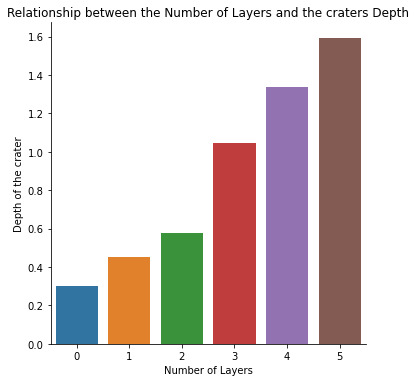
A positive correlation is observed between the number of layers and the depth of the crater. The number of layers of the the crater increases with the increase in the depth of the crater.
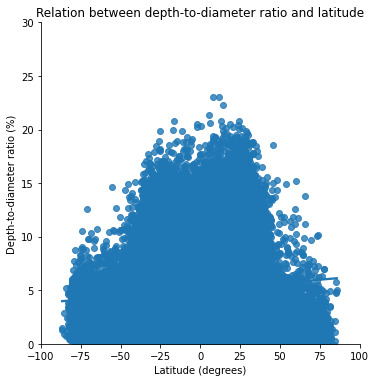
The graph depicting the relationship between the latitude and the depth to diameter ratio. To be honest, I think this is the most interesting plot out of all.
From this graph it is quite obvious that this ratio is higher for lower latitudes (between -40° and +40° approximately). This correlates with the hard, volcanic terrains which are concentrated around these lower latitudes.
On the other hand, the depth-to-diameter ratio is lower for higher latitudes (below -40° and above +40°). This correlates with the soft, ice-rich terrains which are concentrated around these higher latitudes (closer to the poles).
Which proves my initial hypothesis that the depth-to-diameter ratio depends on the type of terrain where the impact occurs. The harder the terrain, the higher the depth-to-diameter ratio, and the softer the terrain, the lower the depth-to-diameter ratio.
Across the surface of a planetary body, one might expect the ratio of a crater's depth to diameter to be constant since it is a gravity-dominated feature (Melosh, 1989). But, while gravity dominates, terrain properties control this final ratio. Craters are shallower near the equator and deeper near the poles, and this effect persists up to the D <= 30 km range.
Congratulations on making to the end of this article!!
Thank You for your time and patience.
#mars#martian craters#data#data science#data management#datavisualization#nastya titorenko#planet of the apes#craters#college#students#course#research#education#technology#astronomy#marscraterstudy
8 notes
·
View notes
Text
Mars Study [Week 3]
Dear Reader,
For this week assignment, I made few data management decisions based on the frequency distributions I computed in my previous work to understand my data well and find the answers to my research question.
Here are the 3 data management decisions I made :
- Decision 1 : To compute the depth-to-diameter ratio and store it in a new variable d2d_ratio. This value is in percentage and is computed by (depth/diameter)*100.
- Decision 2 : To split the crater diameters into 7 ranges which makes the frequency distribution easier to interpret. The range is given as 3-5km, 5-10km, 10-20km, 20-50km, 50-100km, 100-200km and 200-500km.
- Decision 3 : To split the depth-to-diameter ratio into 5 ranges for clarity. The ranges are 0-5%, 5-10%, 10-15%, 15-20% and 20-25%.
After implementing these 3 decisions on my data, I computed the frequency distributions for the following 2 variables :
- Crater diameter
- Crater depth-to-diameter ratio
Here is my code [in Python] :
#importing the required library import pandas import numpy #reading the mars dataset data=pandas.read_csv('marscrater_pds.csv', low_memory=False) print('number of observations(row)') print(len(data)) print('number of observations(column)') print(len(data.columns)) print('displaying the top 5 rows of the dataset') print(data.head())
#dropping the unused columns from the dataset data = data.drop('CRATER_ID',1) data = data.drop('CRATER_NAME',1) data = data.drop('MORPHOLOGY_EJECTA_1',1) data = data.drop('MORPHOLOGY_EJECTA_2',1) data = data.drop('MORPHOLOGY_EJECTA_3',1)
print('Selected rows with diameter greater than 3km') data1=data[(data['DIAM_CIRCLE_IMAGE']>3)] print(data1.head())
# Frequency distributions # Crater diameter print('Count for crater diameters (for diameter greater than 3km)') c1=data1['DIAM_CIRCLE_IMAGE'].value_counts(sort=True) print(c1) p1=data1['DIAM_CIRCLE_IMAGE'].value_counts(sort=True, normalize=True)*100 print(p1)
# Crater depth print('Count for crater depth') c2=data1['DEPTH_RIMFLOOR_TOPOG'].value_counts(sort=True) print(c2) p2=data1['DEPTH_RIMFLOOR_TOPOG'].value_counts(sort=True, normalize=True)*100 print(p2)
#Number of layers print('Count for number of layers') c3=data1['NUMBER_LAYERS'].value_counts(sort=True) print(c3) p3=data1['NUMBER_LAYERS'].value_counts(sort=True, normalize=True)*100 print(p3)
#creating the copy of the subset data data2=data1.copy()
#computing the depth to diameter ratio as a percentage and saving it in a new variable d2d_ratio data2['d2d_ratio']=(data2['DEPTH_RIMFLOOR_TOPOG']/data2['DIAM_CIRCLE_IMAGE'])*100
# Split crater diameters into 7 groups to simplify frequency distribution # 3-5km, 5-10km, 10-20km, 20-50km, 50-100km, 100-200km and 200-500km data2['D_range']=pandas.cut(data2.DIAM_CIRCLE_IMAGE,[3,5,10,20,50,100,200,500]) #frequency distribution for D_range c4=data2['D_range'].value_counts(sort=True) print('Count for crater diameter (per ranges)') print (c4) p4=data2['D_range'].value_counts(sort=True, normalize=True)*100 print('Percentage for crater diameter (per ranges)') print (p4)
# Split crater depth-to-diameter ratios into 5 groups to simplify frequency distribution # 0-5%, 5-10%, 10-15%, 15-20% and 20-25% data2['d2d_range']=pandas.cut(data2.d2d_ratio,[0,5,10,15,20,25]) #frequency distribution for d2d_range c5=data2['d2d_range'].value_counts(sort=True) print('count for crater depth to diameter ratio') print(c5) p5=data2['d2d_range'].value_counts(sort=True,normalize=True)*100 print('percentage for crater depth to diameter ratio') print(p5)
Here is the output for the code :
number of observations(row) 384343 number of observations(column) 10 displaying the top 5 rows of the dataset CRATER_ID CRATER_NAME ... MORPHOLOGY_EJECTA_3 NUMBER_LAYERS 0 01-000000 ... 0 1 01-000001 Korolev ... 3 2 01-000002 ... 0 3 01-000003 ... 0 4 01-000004 ... 0
[5 rows x 10 columns] Selected rows with diameter greater than 3km LATITUDE_CIRCLE_IMAGE ... NUMBER_LAYERS 0 84.367 ... 0 1 72.760 ... 3 2 69.244 ... 0 3 70.107 ... 0 4 77.996 ... 0
[5 rows x 5 columns] Count for crater diameters (for diameter greater than 3km) 3.02 317 3.03 309 3.06 308 3.05 305 3.01 305
60.07 1 69.95 1 100.78 1 118.24 1 67.50 1 Name: DIAM_CIRCLE_IMAGE, Length: 6039, dtype: int64 3.02 0.398356 3.03 0.388303 3.06 0.387047 3.05 0.383277 3.01 0.383277
60.07 0.001257 69.95 0.001257 100.78 0.001257 118.24 0.001257 67.50 0.001257 Name: DIAM_CIRCLE_IMAGE, Length: 6039, dtype: float64 Count for crater depth 0.00 12821 0.07 1564 0.08 1534 0.10 1475 0.11 1448
3.80 1 2.82 1 2.95 1 2.94 1 3.03 1 Name: DEPTH_RIMFLOOR_TOPOG, Length: 296, dtype: int64 0.00 16.111439 0.07 1.965392 0.08 1.927693 0.10 1.853551 0.11 1.819621
3.80 0.001257 2.82 0.001257 2.95 0.001257 2.94 0.001257 3.03 0.001257 Name: DEPTH_RIMFLOOR_TOPOG, Length: 296, dtype: float64 Count for number of layers 0 60806 1 14633 2 3309 3 739 4 85 5 5 Name: NUMBER_LAYERS, dtype: int64 0 76.411526 1 18.388479 2 4.158237 3 0.928660 4 0.106815 5 0.006283 Name: NUMBER_LAYERS, dtype: float64 Count for crater diameter (per ranges) (3, 5] 32084 (5, 10] 23135 (10, 20] 13470 (20, 50] 8818 (50, 100] 1766 (100, 200] 255 (200, 500] 45 Name: D_range, dtype: int64 Percentage for crater diameter (per ranges) (3, 5] 40.320209 (5, 10] 29.073932 (10, 20] 16.927852 (20, 50] 11.081648 (50, 100] 2.219346 (100, 200] 0.320460 (200, 500] 0.056552 Name: D_range, dtype: float64 count for crater depth to diameter ratio (0, 5] 41025 (5, 10] 15957 (10, 15] 8973 (15, 20] 773 (20, 25] 18 Name: d2d_range, dtype: int64 percentage for crater depth to diameter ratio (0, 5] 61.464357 (5, 10] 23.907051 (10, 15] 13.443502 (15, 20] 1.158122 (20, 25] 0.026968 Name: d2d_range, dtype: float64
After studying the results, we can conclude the following:
We can see the craters diameter follows a trend, the smaller the craters, the more frequent they are.
A very similar trend is found when looking at the depth-to-diameter ratio, the smaller this ratio, the more frequently it occurs. This seems to correlate with the diameter frequency distribution. It seems that smaller craters have a smaller depth-to-diameter ratio, while the bigger craters seem to have a bigger depth-to-diameter ratio as well. This would mean that there is no linear relationship between depth and diameter, as one would expect, but rather some exponential relationship between these 2 values.
Thank You for investing your time in reading this article.
#science#technology#astronomy#mars#martian craters#datavisualization#data science#data management#education#college#course#nasa#student#research#planets
1 note
·
View note
Text
Mars Study [Week 2]
Dear Reader,
This week I have been working on the following three variables:
1. DIAM_CIRCLE_IMAGE – diameter from a non-linear least squares circle fit to the vertices selected to manually identify the crater rim (units are km)
2. DEPTH_RIMFLOOR_TOPOG – average elevation of each of the manually determined N points along (or inside) the crater rim(units are km)
Depth Rim - Points are selected as relative topographic highs under the assumption they are the least eroded so most original points along the rim Depth Floor – Points were chosen as the lowest elevation that did not include visible embedded craters
3. NUMBER_LAYERS – the maximum number of cohesive layers in any azimuthal direction that could be reliably identified
Here is my code [in Python] :
#importing the required library import pandas import numpy #reading the mars dataset data=pandas.read_csv('marscrater_pds.csv', low_memory=False) print('number of observations(row)') print(len(data)) print('number of observations(column)') print(len(data.columns)) print('displaying the top 5 rows of the dataset') print(data.head())
#dropping the unused columns from the dataset data = data.drop('CRATER_ID',1) data = data.drop('CRATER_NAME',1) data = data.drop('MORPHOLOGY_EJECTA_1',1) data = data.drop('MORPHOLOGY_EJECTA_2',1) data = data.drop('MORPHOLOGY_EJECTA_3',1)
print('Selected rows with diameter greater than 3km') data1=data[(data['DIAM_CIRCLE_IMAGE']>3)] print(data1.head())
# Frequency distributions # Crater diameter print('Count for crater diameters (for diameter greater than 3km)') c1=data1['DIAM_CIRCLE_IMAGE'].value_counts(sort=True) print(c1) p1=data1['DIAM_CIRCLE_IMAGE'].value_counts(sort=True, normalize=True)*100 print(p1)
# Crater depth print('Count for crater depth') c2=data1['DEPTH_RIMFLOOR_TOPOG'].value_counts(sort=True) print(c2) p2=data1['DEPTH_RIMFLOOR_TOPOG'].value_counts(sort=True, normalize=True)*100 print(p2)
#Number of layers print('Count for number of layers') c3=data1['NUMBER_LAYERS'].value_counts(sort=True) print(c3) p3=data1['NUMBER_LAYERS'].value_counts(sort=True, normalize=True)*100 print(p3)
First, I have decided to remove the unnecessary columns from my dataset, i.e. the variables that I will not use in my research project in the future: the crater ID (CRATER_ID), the crater name (CRATER_NAME), the description of ejecta morphology (MORPHOLOGY_EJECTA_1, MORPHOLOGY_EJECTA_2, MORPHOLOGY_EJECTA_3) . This was done by using the command data.drop.
Second, I have decided to work with a sample of craters for my research. So, I selected the craters whose diameter was greater than 3km in order to limit the number of records, and also in order to avoid measurement uncertainties the diameter of smaller craters due to data resolution.
The ‘p’ values were multiplied by 100 in order to get the values directly in percentage (easier to read).
The output of the program is given below:
number of observations(row) 384343 number of observations(column) 10 displaying the top 5 rows of the dataset CRATER_ID CRATER_NAME ... MORPHOLOGY_EJECTA_3 NUMBER_LAYERS 0 01-000000 ... 0 1 01-000001 Korolev ... 3 2 01-000002 ... 0 3 01-000003 ... 0 4 01-000004 ... 0
[5 rows x 10 columns] Selected rows with diameter greater than 3km LATITUDE_CIRCLE_IMAGE ... NUMBER_LAYERS 0 84.367 ... 0 1 72.760 ... 3 2 69.244 ... 0 3 70.107 ... 0 4 77.996 ... 0
[5 rows x 5 columns] Count for crater diameters (for diameter greater than 3km) 3.02 317 3.03 309 3.06 308 3.05 305 3.01 305
60.07 1 69.95 1 100.78 1 118.24 1 67.50 1 Name: DIAM_CIRCLE_IMAGE, Length: 6039, dtype: int64 3.02 0.398356 3.03 0.388303 3.06 0.387047 3.05 0.383277 3.01 0.383277
60.07 0.001257 69.95 0.001257 100.78 0.001257 118.24 0.001257 67.50 0.001257 Name: DIAM_CIRCLE_IMAGE, Length: 6039, dtype: float64 Count for crater depth 0.00 12821 0.07 1564 0.08 1534 0.10 1475 0.11 1448
3.80 1 2.82 1 2.95 1 2.94 1 3.03 1 Name: DEPTH_RIMFLOOR_TOPOG, Length: 296, dtype: int64 0.00 16.111439 0.07 1.965392 0.08 1.927693 0.10 1.853551 0.11 1.819621
3.80 0.001257 2.82 0.001257 2.95 0.001257 2.94 0.001257 3.03 0.001257 Name: DEPTH_RIMFLOOR_TOPOG, Length: 296, dtype: float64 Count for number of layers 0 60806 1 14633 2 3309 3 739 4 85 5 5 Name: NUMBER_LAYERS, dtype: int64 0 76.411526 1 18.388479 2 4.158237 3 0.928660 4 0.106815 5 0.006283 Name: NUMBER_LAYERS, dtype: float64
We can draw a few conclusions from these results:
- The smaller the craters, the more frequent they are. Larger craters occur less often than smaller craters;
- Same applies for crater depth. The shallower the craters, the more frequently they occur. This already seems to show some relationship between crater depth and crater diameter : smaller and shallower craters seem more frequent than bigger and deeper ones.
Thank You for investing your time in reading this article.
#science#technology#astronomy#mars#marcian craters#datavisualization#data science#education#college#course#student#research#nasa#datamanagement#planets
76 notes
·
View notes
Text
Analysis of the depth-diameter relationship of Martian craters
Dear readers,
I am writing this blog as a part of my research work for the course data management and visualization which is offered by Wesleyan University.
My research focuses on finding the correlation between the depth and diameter of the Mars craters and how it affects the crater morphology.
This study is based on the global database for Mars that contains 378,540 craters statistically complete for diameters D ≥ 1 km which is created by Stuart Robbins.
Unique Identifier: CRATER_ID
Variable Names: CRATER_ID, LATITUDE_CIRCLE_IMAGE, LONGITUDE_CIRCLE_IMAGE, DIAM_CIRCLE_IMAGE, DEPTH_RIMFLOOR_TOPOG, MORPHOLOGY_EJECTA_1, MORPHOLOGY_EJECTA_2, MORPHOLOGY_EJECTA_3, NUMBER_LAYERS
More information about the dataset is available at: http://about.sjrdesign.net/files/thesis/RobbinsThesis_LargeMB.pdf
Impact craters are common geomorphological features on Mars. The density of craters is different among various regions. Higher crater density means older terrain. Craters can be divided into two types by the interior morphology: simple and complex. The cavity of Simple craters is bowl-shape, and complex craters display various interior features, such as central peaks. The depth and diameter relationship is one of the most important characteristics of craters. The depth/diameter ratio (d/D) of simple craters is larger than that of complex craters.
Across the surface of a planetary body, one might expect the ratio of a crater's depth to diameter to be constant since it is a gravity-dominated feature (Melosh, 1989). But, while gravity dominates, terrain properties control this final ratio. Craters are shallower near the equator and deeper near the poles, and this effect persists up to the D <= 30 km range.
Here, I will be investigating the relationship of crater diameter and depth in different regions on Mars in order to understand how the geology affects crater d/D. The d/D ratios of craters can be used to obtain information on relative degrees of crater degradation. With the use of d/D ratio we can determine the diameter at which an impact crater will transition from simple to complex morphology. Which will help us classify the craters based on the given diameter and depth measurements. This information will also help us predict the depth that should be present given a particular size diameter crater.
The aim of this research work:
To establish a relationship between the depth and diameter of the mars craters.
To find the region with the deepest craters.
Refrences:
http://about.sjrdesign.net/files/thesis/RobbinsThesis_LargeMB.pdf
https://ui.adsabs.harvard.edu/abs/2013MsT.........12H/abstract
https://www.mtholyoke.edu/courses/mdyar/theses/Jared%20Howenstine%20thesis.pdf
https://ui.adsabs.harvard.edu/abs/2017AGUFMEP53B1713K/abstract
Thank you for investing your time to read this article.
#science#technology#astronomy#mars#planets#datavisualization#education#college#courses#research#nasa#datamanagement#data science
8 notes
·
View notes